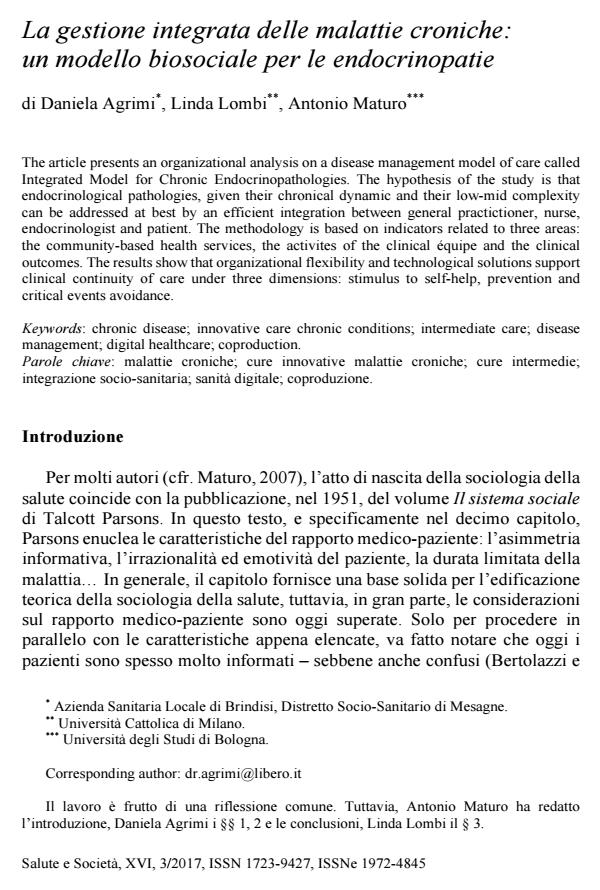La gestione integrata delle malattie croniche: un modello biosociale per le endocrinopatie
Journal title SALUTE E SOCIETÀ
Author/s Daniela Agrimi, Linda Lombi, Antonio Maturo
Publishing Year 2017 Issue 2017/3
Language Italian Pages 17 P. 167-183 File size 233 KB
DOI 10.3280/SES2017-003013
DOI is like a bar code for intellectual property: to have more infomation
click here
Below, you can see the article first page
If you want to buy this article in PDF format, you can do it, following the instructions to buy download credits

FrancoAngeli is member of Publishers International Linking Association, Inc (PILA), a not-for-profit association which run the CrossRef service enabling links to and from online scholarly content.
The article presents an organizational analysis on a disease management model of care called Integrated Model for Chronic Endocrinopathologies. The hypothesis of the study is that endocrinological pathologies, given their chronical dynamic and their low-mid complexity can be addressed at best by an efficient integration between general practictioner, nurse, endocrinologist and patient. The methodology is based on indicators related to three areas: the community-based health services, the activites of the clinical équipe and the clinical outcomes. The results show that organizational flexibility and technological solutions support clinical continuity of care under three dimensions: stimulus to self-help, prevention and critical events avoidance.
Keywords: Chronic disease; innovative care chronic conditions; intermediate care; disease management; digital healthcare; coproduction.
- Agrimi D. et al. (2016). Valutare la co-produzione. Il caso delle politiche di profilassi iodica. MECOSAN 96-2015.
- Bertolazzi A., Maturo A. (2016). Salute e malattia nella web society. In: Lombi L. e Stievano A., a cura di, La professione infermieristica nella web society. Mila-no: FrancoAngeli.
- Bowman S. et al. (2012). Use of evidence to support healthy public policy: a policy effectiveness–feasibility loop. Bull World Health Organ, 90: 847-853.
- Coleman K. et al. (2009). Evidence On The Chronic Care Model In The New Millennium. Health Affairs, 28(1): 75-85.
- Hm Chen A. et al. (2013). eReferral — A New Model for Integrated Care. The New England Journal of Medicine, 368(26): 2450-53.
- Istituto Superiore di Sanità (2005). PNLG Il coinvolgimento dei cittadini nelle scelte in Sanità Una rassegna di studi, esperienze, teorie. Ministero della Salute: Milano, dicembre 2005.
- Kaufman S.R. (2010). Time, clinic technologies, and the making of reflexive lon-gevity: the cultural work of time left in an ageing society. Sociology of Health and Illness, 32(2): 225-237.
- M. Chen L. et al. (2013). Use of Health IT for Higher-Value Critical Care. The New England Journal of Medicine, 368: 594-597.
- Maturo A. (2007). Sociologia della malattia. Milano: FrancoAngeli.
- Maturo A., Mori L., Moretti V. (2016). An Ambiguous Health Education: The Quantified Self and the Medicalization of the Mental Sphere. Italian Journal of Sociology of Education, 8(3): 248-268.
- Pacini F. et al. (2006). European consensus for the management of patients with differentiated thyroid carcinoma of the follicular epithelium. European Journal of Endocrinology, 154(6): 787-803.
- Pearce S.H.S. et al. (2013). ETA Guideline 2013: Management of Subclinical Hy-pothyroidism. Eur Thyroid J., 2(4): 215-228. DOI: 10.1159/00035650
- Stagnaro-Green A. et al. (2011). Guidelines of the American Thyroid Association for the Diagnosis and Management of Thyroid Disease During Pregnancy and Postpartum. Thyroid, 21(10): 1081-1125.
- WHO Europe (2003). Are disease management programmes (DMPs) effective in improving quality of care for people with chronic conditions?. Consultabile sul sito internet: http://www.euro.who.int/en/data-and-evidence/evidence-informed-policy-making/publications/pre2009/are-disease-management-programmes-dmps-effective-in-improving-quality-of-care-for-people-with-chronic-conditions
- WHO global report (2002). Innovative Care for Chronic Conditions. Consultabile sul sito internet: http://www.who.int/diabetes/publications/icccreport/en/
Daniela Agrimi, Linda Lombi, Antonio Maturo, La gestione integrata delle malattie croniche: un modello biosociale per le endocrinopatie in "SALUTE E SOCIETÀ" 3/2017, pp 167-183, DOI: 10.3280/SES2017-003013